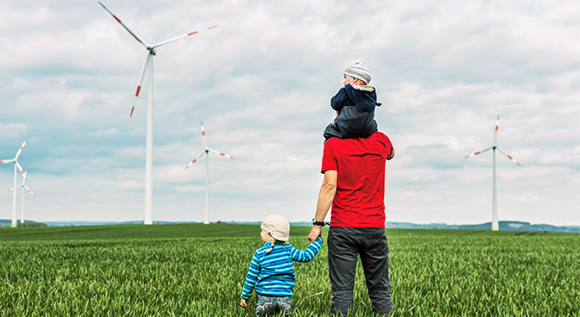Renewable energy: levelling the playing field
Baake: “We still need the citizens’ energy companies in the next stage of the energy transition.”
 © Fotolia / Jens Ottoson
© Fotolia / Jens Ottoson
More solar and wind power: renewables are to become the mainstay of our electricity supply, covering 40-45 per cent by 2025 and 80 per cent in 2050. Germany is well on track to achieve this: last year, a new record of close to one-third was reached (32.6 per cent), and the technologies are learning to stand on their own two feet.
So the support they are getting from the Renewable Energy Sources Act is being changed – the new arrangements should be in place by next year at the latest. And then, it won’t be the Bundestag and the Bundesrat that determine the price of carbon-free green electricity but rather competition for the cheapest solution. “Who bids less?” is the principle. The less support the plant operators say they need, the greater their chance to win funding in a competitive auction.
Lowering the financial barriers in the way of citizens’ projects...
As Rainer Baake, State Secretary in the Federal Ministry for Economic Affairs and Energy, stressed, it is vital for everyone to have a fair chance in these auctions. “Maintaining the current level of stakeholder diversity in the field of renewable energy is key for Germany to be able to reach its expansion targets,” he said last week at “E-World energy & water”. “The expansion of renewables has been based on the commitment of a variety of individuals, companies and associations. In particular, citizens' energy initiatives have fostered public acceptance of the expansion of renewables, as many of them are anchored at local level,” he went on. “We still need them in the next stage of the energy transition.”
For this reason, it is to become easier for locally based citizens’ energy initiatives to compete for onshore wind energy funding – the rules on their participation in the auctions are being relaxed. Unlike those of the major players, citizens’ energy projects will not be required to present an authorisation under “immissions rules” when they bid for funding. That is the concept presented in Essen by State Secretary Rainer Baake.
… and thus the financial risk borne by the bidders
Wind energy projects need to be far advanced before they can obtain a permit under immissions rules. Generally, the project development takes three to five years and eats up as much as ten per cent of the overall costs. If citizens’ energy companies don’t need the permit in order to submit a bid, they are spared all the expensive and time-consuming preparations, which would be a much greater burden for them than for larger bidders. Instead, they get the necessary certainty for their investment at an early stage so that they can develop and build new wind power projects.
The special rule does not affect the level of funding determined by auction, or the rate of expansion of wind energy in line with fixed milestones: the citizens’ projects are not exempted from the bidding process. They just have to comply with simpler rules. From early 2015, a Working Group set up as part of the “Electricity Market Platform”, a dialogue forum of the Federal Ministry for Economic Affairs and Energy, discussed this in detail with the various stakeholders. The outcome of this process has now been included in the key elements.
Who will the special rule apply to?
The simplified rules on participation in the wind power auctions are to apply to “locally anchored” citizens’ energy companies, and these have to consist of at least ten private citizens. These private citizens must hold the majority of voting rights (51 per cent), and they must also be registered as resident in the district in which the project is to be built. Furthermore, no shareholder may hold more than 10 per cent of the shares. Further conditions also apply: the “locally anchored citizens’ energy companies” may only erect one wind farm per year with a maximum of six turbines and a total output of 18 megawatts.
Offshore wind farms: better integration, cost-efficient planning
The specific proposals on stakeholder diversity form part of a revised paper containing principles for the reform of the Renewable Energy Sources Act (only in German). It is based on the key elements from the summer of 2015 and also contains the first details of the auction design for offshore wind. In future, customised funding models will apply to each of the key technologies – solar farms, onshore wind and offshore wind.
Because offshore wind farms need to be carefully planned a long time ahead, the new auction model will only apply to installations coming on stream from 2025 (with a transition phase from 2021). The sites on which wind farms will be erected are stipulated in advance and tested for suitability, and all the bidders will be furnished with the same information, e.g. about the wind conditions.
Solar farms: continuing a successful competition
In the case of solar farms, or “ground-mounted PV installations”, the auction system has been tried out over the last year. The first round started in February 2015, and the fourth auction is currently underway. Experience shows that the competition between the bidders is working well, and was extremely brisk in all three previous rounds. The price level has also fallen from round to round – good news for electricity consumers. While the remuneration for electricity generated in ground-mounted PV installations totalled an average 9.41 cents per kilowatt hour (ct/kWh) in 2014, competition cut this to 8.00 ct/kWh by the end of 2015. The future funding will therefore be closely oriented to these pilot auctions.
Unlike wind power, there is no need for any special rules for participation in the auctions, since the smaller stakeholders are protected by the “de minimis threshold” of one megawatt. Those installing lower-capacity PV modules will continue to receive a level of funding stipulated by law.

